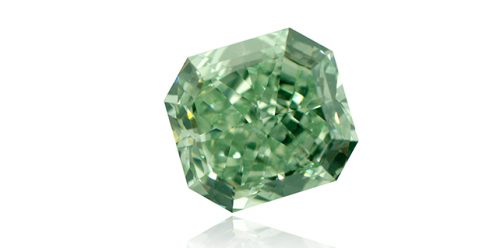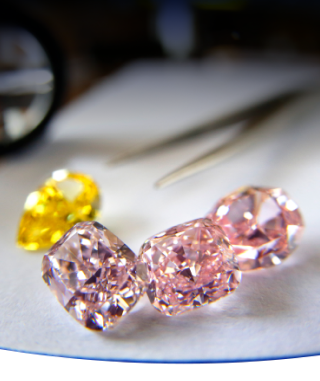As the demand for green fancy color diamonds grows, professionals who market them will benefit from increased knowledge and key talking points about these rare stones. For example, a unique characteristic of green diamonds is the fact that they are the only colored diamonds that obtain their color after they are formed.
This article by Dr. Daniel Howell summarizes essential information about green fancy color diamonds that will be useful when selling them.
Of all the fancy colors that diamonds can exhibit, green is the only one that can be created naturally once the diamond has been brought to the surface. All other colors are produced while the diamond is deep within the Earth under high pressure and at high temperatures, either by impurities in the carbon lattice (in the case of yellow and blue diamonds) or by its deformation (in the case of brown and red / pink diamonds). A natural green color is the result of radiation damaging the diamond. This can occur when the diamond is still in the volcanic pipe (kimberlite) that brought it to the surface, or even once it has been eroded from there and found in a river or alluvial deposit. If the diamond resides in close contact with another mineral or fluid that contains a high concentration of radioactive elements (e.g. uranium), that can affect it. The radiation emitted by the radioactive minerals or fluids penetrates the diamond and knocks carbon atoms out of the diamond’s crystal lattice, creating holes or vacancies. It is this defect, or imperfection in the diamond lattice that causes the absorption of predominantly red light, which results in perceived green color. Radiation damage can also occur when the diamond is deep in the Earth. However, the high temperature at which the diamond resides in the Earth is likely to cause the defects to change, reducing its green color and potentially changing it to brown or adding a yellow component [1].
Rough green diamonds are often known for exhibiting just a thin skin of color. This is the result of two factors, (i) the energy of the radiation which caused the damage, and (ii) the length of time for which the diamond was exposed to radiation. Using uranium as an example, when it undergoes radioactive decay, it can emit both alpha and beta radiation. Alpha radiation has less energy than beta, and is therefore less able to fully penetrate the diamond. This means that a diamond subjected only to alpha radiation will have a damaged / colored surface, while one subjected only to beta radiation will have a deeper color penetration, beyond just a thin skin. While the type of radiation affects the physical depth of color of a diamond, the amount of time a diamond is subjected to radiation will affect the strength of its color. This is where the age of a diamond plays a significant role. Radioactive elements can emit radiation for millions, or even billions of years. The longer a diamond is irradiated, the stronger its color will be.

Understanding the processes that cause diamonds to become green is integral to determining whether a green diamond is natural or man-made. When a cut diamond exhibits a green coloration that aligns perfectly to its facets, gem labs know the radiation occurred after the diamond was cut, which means the color is man-made. In fact, the radiation of a diamond by scientist Sir William Crookes in 1904 is the first documented case of man-made diamond color treatment. Sir Crookes placed a diamond in radium salts for several years. When he retrieved the diamond, it had turned green and had substantial body color. This treatment is very uncommon today, as radioactive material can penetrate into cracks in the diamond, making the diamond itself radioactive [2]. Modern treatments typically use low-energy electron beams to irradiate a diamond, which affect the diamond’s surface and leave no residual radioactivity in the diamond. Natural green diamonds are not radioactive, as the source of the radiation is no longer present once they have been unearthed.
As with any natural fancy color diamond, the skill of crafting a beautiful diamond from the rough that likely lacks an even color distribution, lies firmly in the hands of the cutter. Polishing away the surface of a rough green diamond can remove all of its colored skin, leaving just the white diamond beneath. The best cutters work with a stone’s natural shape and color distribution to maximize its beauty and rarity.
References:
[1] Nasdala et al., 2013. Radio-colouration of diamond: a spectroscopic study. Contributions to Mineralogy and Petrology, 165, 843-861
[2] Nazz and Johnson, 2013. Green diamond, treated with radioactive salt. Gems & Gemology, Spring 2013, 49(1).


